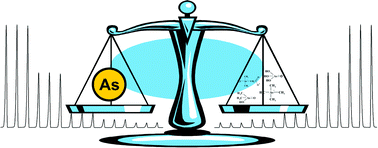The widespread occurrence and toxicity of arsenic has demanded the development of rapid and accurate methods for its analysis. A flow injection method with inductively coupled plasma mass spectrometry (ICPMS) as an arsenic-selective detector was optimized. Flow injection was carried out using a Hewlett–Packard 1100 series liquid chromatograph coupled with an Agilent 7500ce ICPMS. Two different eluents were used, 0.3% HNO3 with 10% methanol (v/v) and 20 mM phosphate buffer with 10% methanol (pH = 5.6), both supplied at 0.15 cm3 min−1. The determined method detection limits were 38 ng dm−3 using the 0.3% nitric acid and 62 ng dm−3 using the 20 mM phosphate buffer as eluent. The accuracy of the method was evaluated using various reference materials with low matrix, such as NIST certified reference water 1643e and in high matrix materials like NIES human urine 18, and extracts of biological reference materials, including BCR 422, DOLT 3, DORM 2, IAEA 407, LUTS 1, and TORT 2. The arsenic values determined by the flow injection ICPMS method were in good agreement with results obtained from total arsenic analysis after microwave assisted digestion.

You have access to this article
 Please wait while we load your content...
Something went wrong. Try again?
Please wait while we load your content...
Something went wrong. Try again?


 Please wait while we load your content...
Please wait while we load your content...